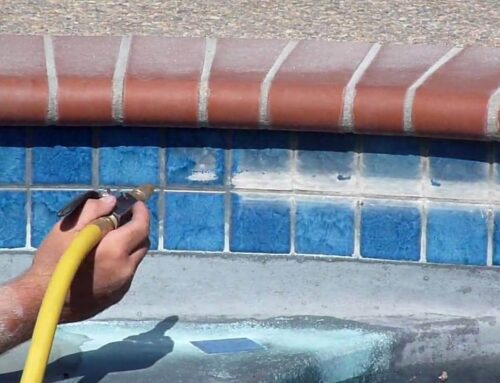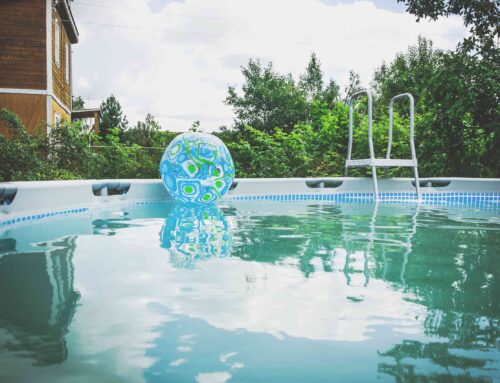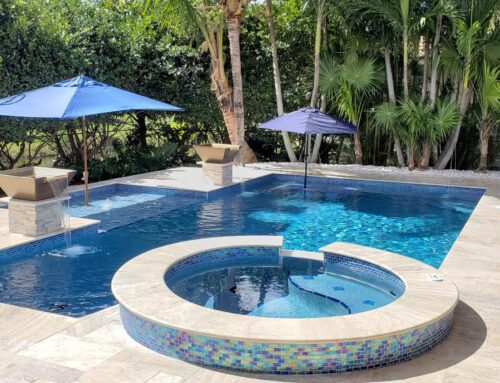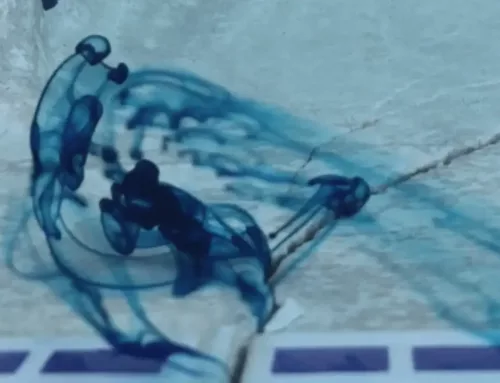Built correctly, a swimming pool will last a lifetime. However, it’s not uncommon for swimming pools to need minor, or even major, repairs frequently. If your pool shell is chipping, cracking, or fading, you’ve come to the right place. In this article, you’ll learn what kind of damage to a pool you can quickly fix yourself and how to do that. And, you’ll learn the types of renovation and swimming pool repair that is best left to the professionals.
Find the Damage First
Before you roll up your sleeves, it’s a good idea to know exactly what you’re dealing with. If your pool water level is dropping, that could be a sign of a leak, or it could be simple evaporation. Florida gets intense sunlight over the summer. During especially dry and hot days, your pool might lose up to a quarter-inch of water to evaporation over 24 hours. A quick and easy way to see if you’re losing water due to a leak or evaporation is the so-called “bucket test.” First, mark a waterline inside a bucket and on your pool. Fill the bucket with water from your pool up to the line you marked and let it float in the pool. Don’t use the pool for a few days, and then check the water lines. If the water in your pool and the bucket are both reduced the same amount from the marked lines, your pool has no leaks. If the pool water is significantly lower from the mark than the bucket, you’ve got a problem. If the water levels are extremely disparate, you should consider getting a professional opinion on how to proceed.
Repairing Cracks in the Concrete
Whether you have a leak or not, it’s a good idea to repair any cracks on the shell of your pool. Small cracks in the concrete usually aren’t alarming as the soil around the pool will naturally settle after it’s built. If the crack is longer than two feet and wider than about a quarter-inch, it can be repaired without much hassle. Otherwise, doing a quick fix might lead to bigger problems down the line. First, drain your pool to expose the crack. It’s a good idea to drain the entire pool if the crack needs extensive work as debris is likely to end up in the water. Then, widen the crack with a chisel or flathead screwdriver and use a wire brush to clean the surface of loose bits of concrete. Mix a patching compound with portland cement and work it onto the crack with a trowel. Make sure the area in and around the crack is damp so the concrete will adhere properly. Then, smooth it so it’s flush with the rest of the pool surface and coat it with a layer of epoxy paint so it’s indistinguishable. If pool crack repairs become a commonplace occurrence, even if they’re small.
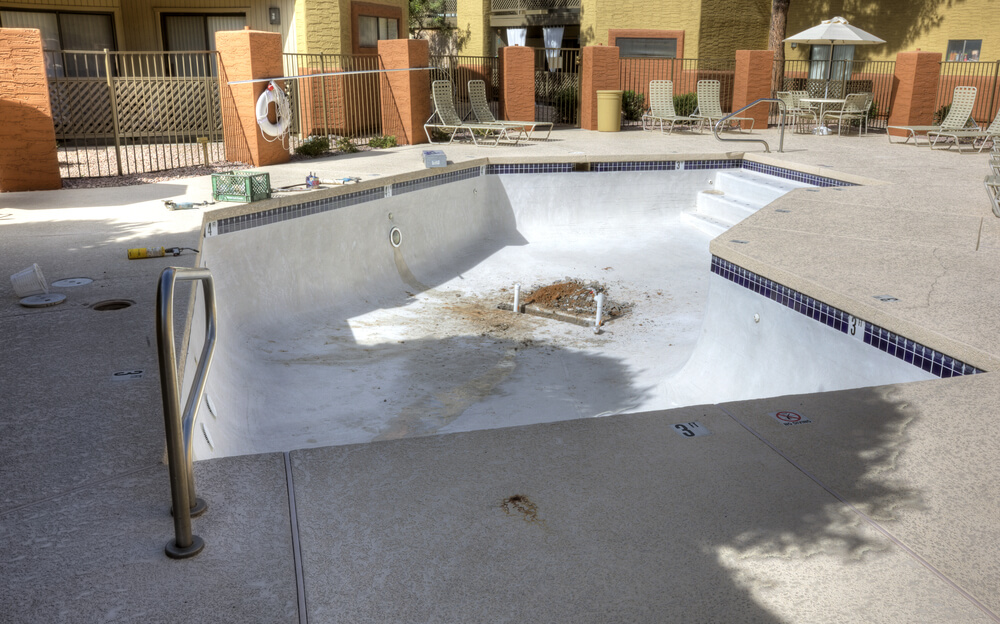
Repairing Vinyl Pool Liners
A tear in the vinyl lining of an above-ground pool can result in its complete collapse. If your above-ground vinyl pool suffers damage, immediately drain the water from it at least to below the level of the damage. To be safe, you might want to drain it entirely. A quick fix if you’re dealing with an accident is duct tape. As soon as a tear happens, stick a piece of duct tape on it underwater and rub it in well. It won’t hold for long, but it will give you time to decide what to do. Then tear is three inches long or shorter, it can be repaired easily with a patch kit. Anything longer than that is risking it. Vinyl pool patching kits work a lot like a bicycle tire patch kit.
You’ll receive a piece of material to glue over the tear and an adhesive to do so. The best thing to do is work on a dry tear, but some kits can be used underwater as well. Follow the instructions on the kit for the best results. Patches aren’t a perfect fix, so make a habit of checking them frequently to see if a leak develops. It’s also worth considering if your vinyl liner is worth repairing. The lifespan of a pool liner depends on things like sun exposure and how well it’s taken care of. However, you can expect the typical liner to last about five to ten years. If your liner is older than that, and tears start to crop up, a complete replacement might be a better option. If you’re unsure about how to proceed, consult a professional in your area.
Repairing Plaster Coating
Pool crack repairs sometimes don’t affect the concrete itself, but the plaster layer on top of it. The plaster layer will also degrade over time, creating a rough surface that’s unpleasant to the touch. It’s not uncommon to address small chips and cracks on the plaster. Eventually, though, your pool will need a new layer of plaster; somewhere around the seven- to ten-year mark. Patching small cracks is not a complicated process than it may seem. For larger swimming pool crack repair, you can use the same method described above for cracks in the concrete. Replace the portland cement with a plaster patching compound and once you work it into the crack, smooth it out with a wet sponge. There are also patching kits that allow you to work underwater. However, they should be reserved for small cracks.
Fiberglass Swimming Pool Repairs
Fiberglass pools are usually a good investment, but they need recoating every so often to stay in good shape. If the surface gel coat is scratched or chipped, you can make a small repair fairly easily. Drain the pool entirely or up to the damaged area and use 200-grit sandpaper to smooth out the area that you want to recoat. Once it’s sanded, wipe the entire area around the damage clean with an acetone-soaked rag. This will prime it to receive a new layer of gel coat. Then, mix a batch of gel coat and apply it to the area using a felt paint roller. Make sure you get a thick layer on it. Let it dry overnight and apply a second coat, then let the whole thing dry for two days before refilling with water. If the entire gel coat is starting to show signs of wear, it can be recoated in much the same way. A full recoating is an extensive process but proceeds in much the same way. You’ll have to sand and clean the entire pool meticulously and then apply the coating.
An Ounce of Prevention
To avoid having to repair your pool frequently, follow these guidelines.
- Always have a working pool pump. If it breaks down or stops working, repair or replace it quickly.
- Check your chemical balance often. Soft water can slowly dissolve grouting, so make sure you’re keeping calcium levels in check and chlorinating properly.
- Clean the pool regularly. Any debris or organic matter that accumulates can promote algal growth.
For a pool surface that lasts a very long time and needs little upkeep, consider tile. A tiled pool, with the proper care, is the most durable option for a pool surface. The only thing you’ll have to worry about is the loss of grout to soft water.
Tile is more expensive than other types of surfaces, but it will save you a lot of woes down the road.
A Beautiful Pool Takes Work
Some pool surfaces are easier to repair than others. A tear in the vinyl lining or a small chip on a plaster surface is easy to fix. However, recoating an entire fiberglass pool is no small task. If you want to make sure your pool repairs last, trust a licensed professional. Whether you need pool repairs of any kind, a new pool, or just maintenance tips, trust Florida Pool Patio for all your pool needs. Contact us today for professional assistance with your pool repair project.



